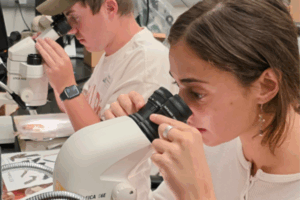Mysteries of the universe
Utah researchers join project to unlock enigma of 'dark energy'
Researchers from the University of Utah are joining forces with others for a universal five-year project that seeks to map the universe and gain insights into the mysteries of dark energy.
In a culture where science fiction reigns as one of the most popular genres for movies and television, the terms "dark matter" and "dark energy" likely convey a sense of foreboding to many.
But they got their label simply because scientists know so little about them, said Angela Berti, a U. postdoctoral researcher working on the project.
"You hear 'dark matter, dark energy' kind of thrown out there, and to the extent that you've kind of read popular science news, you might be aware that the astronomy community and the physics community knows that there's some additional mass out there in the universe," she said.
In the last 20 years, researchers discovered that the universe continues expanding at an increasingly rapid rate, which is considered "strange and unusual," according to Berti.
"We don't really have a great explanation for it. So the placeholder, we call it dark energy, something that's causing the universe to expand faster and faster," she said.
The Dark Energy Spectroscopic Instrument, also known as DESI, in Tucson, Arizona, will collect data on the light from more than 30 million galaxies and other distant objects, which researchers will use to make a 3D map of the universe. DESI captures spectra, which are elements of light that correspond to the colors of the rainbow. Spectras split light into wavelengths, or redshifts, which researchers measure to find the distance to a galaxy or far-off object in space.
The project launched officially in mid-May after years of preparation. About 50 universities are participating in the U.S. and around the world.
With millions of galaxies to map, the researchers will use an algorithm to find the best estimate for distances between objects. Berti's role includes checking data on sample subsets of individual galaxies and spectra to make sure the algorithm data aligns. She will help find objects for which the algorithm is less effective in estimating distances, so researchers can improve the system.
"It's kind of cool because the reason it's really useful is when you have millions and millions of galaxies, you can't do that process by hand for every single one," Berti said.
She's also testing alternative modeling techniques for measuring redshifts.
DESI is the largest project so far to measure "very precisely the expansion rate of the universe, basically to just measure more precisely the rate at which it's expanding, and the rate at which the expansion might be changing," Berti said.
It will measure galaxies in one-third of the entire sky, she said.
The researchers don't know what they'll discover. But to make progress in understanding why the universe is expanding faster and faster, they need to measure that expansion as precisely as possible.
She said the project seeks to indirectly unravel some of the mysteries surrounding dark energy, which like dark matter, has eluded scientists for many years.
"The frustration and the foreboding comes from the fact that we haven't yet figured out what it is. It doesn't mean that we won't figure it out, and it doesn't mean that our current science is wrong, it just means that our current understanding is incomplete. And that's frustrating. ... They're two big, pressing mysteries that are yet uncracked," Berti said.
The project will "help us understand the properties of this unexplained phenomena better, and the more we understand the details about what's going on, the better chance we have of coming up with a theory that we can test," she said.
By Ashley Imlay, first published in KSL.com




